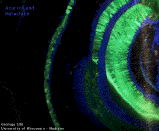PRECIOUS STONES


Prior to 1828, it was used as pigment for ultramarine paint.
For more that 6000 years, it has also been used as an ancient precious stone/gem in Afghanistan, and traded throughout Africa and
Europe.
"Durability": sensitive to heat, acid, alkali
Other comments
Other name: Turkish stone
Turquoise's use dates back to 3000 B.C.- 4000 B.C.+ (Sinai)
Enhancements: impregnated with plastic, parafin, oil
Synthetics: ceramic material containing small blue spheres
Simulants: glass, plastic, dyed material (e.g., calcite)
(b) Malachite:
Geological: Cu-bearing solutions interact with carbonate rocks (cavelike
deposits)
(Ancient) Uses:
Azurite commonly occurs with
malachite (azur-malachite is an intergrowth of the two minerals).
Because of its similarity with malachite (formed in similar way), azurite
has similar
physical properties and uses.
(1) Lapis Lazuli
 See a movie on a lapis (sodalite)
structure!
See a movie on a lapis (sodalite)
structure!
Comments
The name lapis is Persian for blue. Formation of lapis lazuli
Lapis lazuli, is a contact
metamorphic rock with variable composition and varying
physical properties. It usually forms by contact
metamorphism of
limestones.
Uses of lapis, durability, and simulants
Use of lapis lazuli: beads, cabochons, carvings
Copper-bearing minerals formed at low temperatures: turquoise, malacite, and azurite
 Formation of turquoise, malachite, and azurite
Formation of turquoise, malachite, and azurite
(a) Turquoise:
Geographical: well known deposits occur in Persia, Sinai Peninsula, China, Chile, Egypt, Turkey,
Mesoamerica (Arizona)
(3) Malachite and Azurite
(c) Azurite:
![]()
 View some
images of malachite, azurite, and turquoise
View some
images of malachite, azurite, and turquoise
![]()
![]() Pyroxenes
(and Amphiboles), Tourmaline and Garnets
Pyroxenes
(and Amphiboles), Tourmaline and Garnets
 Precious Stones:
Agate and Opal
Precious Stones:
Agate and Opal
![]()